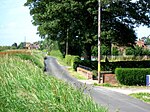Goole railway swing bridge
Bridges across the River Ouse, YorkshireGooleGrade II* listed railway bridges and viaductsIMO numbersNorth Eastern Railway (UK) ... and 2 more
Swing bridges in EnglandUse British English from January 2014

The Skelton Viaduct, also known as the Hook bridge or Goole railway swing bridge, is a large viaducted hogback plate girder bridge with swing span over the River Ouse, Yorkshire near Goole, East Riding of Yorkshire, England. The bridge was designed by Thomas Elliot Harrison for the Hull and Doncaster Branch of the North Eastern Railway and opened in 1869. In the latter part of the 20th century, the bridge became known for the frequent incidents involving ship collisions with the superstructure. As of 2022, it is still in use.
Excerpt from the Wikipedia article Goole railway swing bridge (License: CC BY-SA 3.0, Authors, Images).Goole railway swing bridge
Sandhall Road,
Geographical coordinates (GPS) Address External links Nearby Places Show on map
Geographical coordinates (GPS)
| Latitude | Longitude |
|---|---|
| N 53.71318 ° | E -0.84162 ° |
Address
Sandhall Road
DN14 7RP
England, United Kingdom
Open on Google Maps










